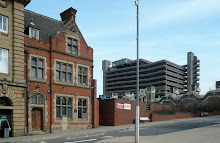| |
| | |
Ant Macari and Oliver Beck Thank You For Staying #2 11/12/09 19:00 - social space, Star and Shadow cinema, Stepney Bank, Newcastle upon Tyne, UK www.platformnortheast.org Thank You for Staying #2 is a re-enactment of a 2008 performance by Raymond Pettibon and Mike Watt for the Earwax series at Riverside Art Museum, LA. This is live art as mimesis which attempts to reveal tensions between aspiration and failure: celebrity and public, plastic and diachronic arts and the boundaries between rural and urban in the context of Americana as experienced by two teenage skater punks growing up in the Scottish Borders. Excerpts from a proposal.... The title 'Thank You for Staying #2' refers to the main difficulty of live art: holding the attention of the audience. Re-enacting 'EARWAX' a performance/ gig hybrid, which happened relatively recently, only some 20 months ago - neither too fresh to be a response or too long to have settled into an intelligible historical context - is like performing a cover version before it's had time to accrue a patina of history. This homage to the progenitors (Pettibon and Watt) of a particular brand of punk by two aspiring devotees (with little to no experience or charisma) is a kind of impotent gesture and brings into focus the trans-Atlantic delay we sometimes experience in cultural exchange in contemporary art. At the centre of human discourse is remix. As well as engaging in a critique on originality, the aim of this action is to examine the nature of the plastic (painting) and the diachronic arts (music) by direct comparison, seeking to give the two an equal duration. Like sand painting or water calligraphy; the artist's material intention is transitory. This aligns visual art with speech music and performance in as much as it brings painting (in this case) to meet with music on its own terms. In Pettibon and Watt's original performance, the drawings which were generated during this performance were kept and displayed in the Riverside Art Museum's programme under the title 'Thank You for Staying,' a nod to the time endured by their audience (90 minutes). Our version of the performance (25 minutes) however, aims to highlight the transitory nature of language in a live situation by destroying the work at the end of the performance by loading a shredder accompanied by screaming. Beck will play riffs and improvisation informed by Watt. Macari will make black and white paintings using a Japanese brush with transducer (pickup) in the style of Pettibon and in response to Beck's playing and informed by stories of Beck's experience as a punk rock fan/ skateboarder growing up in Kelso, UK. Re-enactment itself is interesting as both Beck and Macari grew up in suburban towns with the American subculture of LA and NY in their minds. In an attempt to live out scenarios from the skate videos which had a big influence on them; they would – oblivious to one another – share an aim to re-enact scenes and tricks from these videos, round the back of Kwiksave or the Co-Op in their parochial towns. The rolling hills of the Scottish Borders, scenic though they are, reveal little of the horizon. In this respect those who live there should expect to experience limited horizons both physically and psychological. These conditions often push escapism to its zenith, accounting for the high percentage of addiction and drug related deaths in this area of Scotland. The two share a preoccupation with Americana, a cultural exoticism which represents an extremely different experience to a Borders town. It's a type of escapism in which you can play an active role, with the potential for reinvention and making it your own. The piece asks these questions: What is the value of temporary (plastic) art work in the context of live art? Where should our emphasis lie: on the act or the product of the act? How does one address and gauge aspiration and failure through performance? Background: Visual artists Macari and Beck share a common interest in Americana. Specifically West Coast American punk and DIY culture from the 80s and 90s as a manifestation of escapism to youths growing up in rural and suburban areas in the South of Scotland. Macari and Beck grew up in Galashiels and Kelso respectively; they first met in Gateshead some years later while working as technicians at BALTIC CCA. Both share an interest in performance and art as a way of exploring the potential for reciprocity between image, text, sound and audience. The two have never worked together before, although they would like to start a post-punk band. Somehow, I think this is the closest they'll ever come to achieving that. Visualisation: Two people dressed in a style between LA hillbilly and surf bum standing on a stage containing; a flat top writing desk (featuring a lamp, art materials and a swivelling mirror mounted directly above the work surface by which the audience can view the painting work in progress), a calligraphy brush and paper mounted with transducers, a bass guitar and valve amp, a smaller amp, two microphones with stands, a PA system, a paper shredder and two glasses of water. OB plays bass guitar riffs influenced by Watt. AM makes paintings in response to OB's sounds in the style of Pettibon. Both AM and OB recite poetry and aphorisms into the microphones during the performance. The performance ends with OB and AM screaming (as the expression of cosmic totality in a pre-verbal language) into microphones as they put each painting methodically into a paper shredder. |























